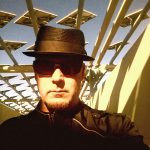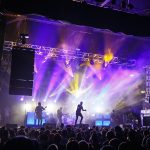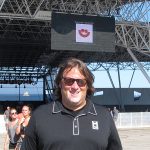Lighting designer Kevin Hardy’s frequent flyer accounts must be too heavy to lift. Now 53, his peripatetic career has taken him to Beijing, London, Sochi, the Vatican, Niagara Falls and most of the U.S. He has applied his art to subjects as diverse as the band Twisted Sister and Barbara Streisand, Keith Olbermann and Howard Stern, the Ohio Ballet and the election of Pope Francis. As PLSN spoke with him in late January, he was gearing up to head to the Trump-less final Republican presidential debate in Iowa, where he would direct lighting for the post-debate “spin room” and other support segments.

Bohemian Beginnings
It would be just a degree or two off plumb to say that Hardy was born into show business. His father was an Expressionist painter, but also was very involved in off-off-Broadway avant-garde theater productions. In fact, the senior Hardy may have created one of the first automated band lighting systems when he ganged together and synchronized about two dozen carousel slide projectors that swathed musicians in psychedelic colors and images.
“This was a time in American theater history when ‘happenings’ were the new thing,” explains Hardy. “I grew up in NYC’s East Village during this very experimental, spontaneous period when people in the arts like Robert Rauschenberg and John Cage were rewriting the rules. Defined roles fell apart, so everybody in a theater group did a bit of everything. My dad did set design and construction, lighting, whatever needed doing.”
By the time he was ten years old, the Hardy boy was accompanying his father on production gigs and pitching in. He found he was attracted to the “show must go on” camaraderie and party atmosphere (play foreboding soap opera organ chord here). “In those days, we used large auto transformer dimmer or piano boards that were about 15 feet wide,” he recalls. “They had a series of giant handles that looked like something from a Frankenstein movie. This was before PAR-64s, so we did it with Century and Strand Lekos, Century Fresnel’s and R-40 strip lights. That was pretty much the standard lighting package of the day.” Doing shows with his pop, “I learned how to run a Carbon Arc Super Trouper spotlight, before HMI bulbs were invented.” Hardy, the youngest crewmember, remembers the time fondly. “It was the 1970s, pot was everywhere, I was this junior high kid hanging out with college kids in a park, smoking dope, doing lighting, building sets outside…it was a blast.” Between plays, the venue also hosted concerts by name bands of the day, at which the theater crew helped with staging and lighting.
Hardy pursued his newfound vocation more formally in East Islip High School’s theater program. “Since by this point I was already doing lights and sets for college productions,” recounts Hardy, “doing it for the high school was a party. It was a great way to meet girls and become part of the social scene.”
Asked if his high school grades held up during this time, after laughing, Hardy replied, “Of course not! Actually, I did really well in all my arts and shop classes.” When it came time to apply for college, he chose Pittsburgh’s Carnegie Mellon University for its famed theatrical production curriculum. “It was obvious that I hadn’t reached the academic heights they usually looked for, but during my admissions interview with Cletus Anderson, I showed him my technical drawings of the stage setups I’d done. The school was impressed, so I was admitted. They give students a very well-rounded exposure to all the disciplines of theater, so I was doing lighting, scenic design, props, costumes, scenery painting, directing, playwriting…it was a very full, exhausting program. My fellow students were exceptional and inspiring to be with.” Again, there was that cohesive ensemble feeling that Hardy describes as “almost military in the way we had each other’s backs. We worked together, lived, ate and partied together for four years.”
In his last semester at CMU, a production internship at the Julliard School got Hardy connected to the New York theater scene. Beginning with the New York Shakespeare Company’s series at Central Park’s Delacorte Theater, more paying gigs soon followed and his career lifted off like a Harrier jump jet.

On the Road Again…and Again
“One day, I got a call from my good friends Scott Maskin and Jimmy Geoghegan about a job loading trucks for a company called See Factor, which was the rock ‘n’ roll touring lighting company in the ‘80s. This is where I first met Nook Schoenfeld [now PLSN’s editor], who took me out on my first road gig, the Talking Heads’ Stop Making Sense tour. Before I knew it, ten years went by. I’d been constantly on the road, most of the time without a home address, doing weeks of 16-hour days for every kind of act, including the Grateful Dead, Jefferson Starship and countless others. I’d usually jump from the end of one tour to another one already out.” He was with See-Factor until 1987, then switched coasts to work for Showlites, the Obie Company and Morpheus Lights in California.
At every juncture of his career, Hardy points out the importance of the synchronicity and camaraderie he felt with his fellow crewmembers. “I see these guys today after 20 years, and we don’t even miss a beat. We’re just a lot older looking! We’re still the same people who shared those ‘I’ve been to hell and back’ experiences during the heyday of heavy metal and big-hair bands. The lighting rigs were massive — 500 PAR cans. The technology was not nearly as refined as it is now, so we were making it up as we were going along. Companies would send us new products free to road test and review, so we got to be actively involved in their development.”
Party Hardy
As Hardy tells it, every stereotype you have about the unhinged Saturnalia of life on the road supporting famous bands is true, and then some. “This was the early ‘80s, when drugs were in vogue and sex wouldn’t kill you. It was a fantasy bubble with its own reality, going from town to town, working hard and partying harder.” After lighting the bands, Hardy would get lit himself.
When he was between tours in Los Angeles, he would take on work through Ocean Rose & Associates as an electrician on television productions like Dick Clark’s Rockin’ New Year’s Eve, MTV music videos and industrials. “Quite honestly, the TV pay was a lot better than the road. Eventually, as I was getting increasingly weary of being on the road, I got more into television and started to settle down in one place. But my worst habits from touring — my drinking and drugging — escalated to the level that I pretty much drank myself out of every job.” Hardy realized he had to sober up.
F. Scott Fitzgerald got it wrong when he said, “In America, there are no second acts.” Just before his 30th birthday, Kevin began his second act. He got into the AA 12-step program and did nothing but go to meetings and work the steps for four months. “It was the hardest thing I’ve ever done. When they learned I’d gotten sober, the friends I’d made in the industry welcomed me right back. Within six months, I looked at my calendar and saw more work than I’d had in five years.”

George and Ringo
Among them, David George and his brother Ringo, old friends from the Obie Company, got in touch about some projects with their new scenic design and production company, George & Goldberg Associates. They hit it off and began working together. Like the proverbial manna, along came a huge contract to stage Barbra Streisand’s return to live performance after decades away — a two-night stand for the grand opening of the MGM Grand in Las Vegas in Dec. 1993.
“The gig went fantastic,” he recalls, which led to his getting back on the radar of a friend from his Showlites days, Oliver “Ollie” Gensler, who’d become a technical director at the MGM Grand. Gensler hired him for the EFX show with the original Phantom of the Opera’s Michael Crawford. He moved to Las Vegas to help put together what was to become, at the time, the largest permanently installed theatrical show in the world. Explains Hardy, “It was the largest lighting package ever — a massive job. It took us a year to load it in, with another six months of tech before we opened. Natasha Katz from Broadway did the lighting design and Paul Turner did the programming. After the show was up and running, we had a nonstop schedule of two shows a day, six days a week.”
No longer a drinker, Hardy found himself at a loss for putting the “viva” in Las Vegas during his down time. “Eventually, I discovered the University of Nevada Las Vegas, which offered a graduate degree in lighting design. I jumped right into that, not necessarily for the degree but to get the creative stimulation, because it was just so dry doing the same EFX show night after night. Brackley Frayer, head of lighting design and UNLV were great — a lifeboat for me, artistically.”
After a year at the school, Hardy became nostalgic for the East Coast, returned to his alma mater, Carnegie Mellon University, and completed a master of fine arts degree in lighting design. Again close to the New York City scene, he landed the position of assistant lighting designer with Stan Pressner and the Lincoln Center’s Summer Theater Festival. About two years later, he met lighting designer David Feldman, who had a contract with CNN. He hired Hardy to be the news network’s night shift lighting director, where he would illuminate such luminaries as Lou Dobbs, Larry King, Aaron Brown, Connie Chung and Anderson Cooper. His first day was August 1, 2001.
The World is Watching
CNN was located at 5 Penn Plaza on West 34th Street, across from Madison Square Garden. Its large balcony had a line of sight with the World Trade Center 3.7 miles to the south. “It was my second month of working there, when September 11 happened, I was CNN’s only lighting director living on the island of Manhattan,” said Hardy. “David Feldman called me after the first plane hit, and told me if I felt comfortable enough in the job to come in. So I got out my bicycle, because I knew the subways would be a nightmare. Just as I walked out the door of my apartment, the second plane hit. I jumped on the bike and rode from 108th Street down to 34th Street. At CNN, it was just me, a couple of camera guys and the anchorman. Reporter Paula Zahn, on what was her first day of working at CNN, with the smoking towers in the background on the patio. We were there for two straight days. All those shots from the CNN news center that the world saw as those horrible days unfolded came from us. For the next year, we were crazy busy with work. Every news anchor in town wanted to shoot out of that CNN studio with that view in the background.”
TV or Not TV
After dips back into the theater pool, including stints as resident lighting designer for the Provincetown Theater, LD at the Wellfleet Harbor Actors Theater and its Julie Harris Stage, more television work followed. Around 2008, he began freelancing for the estimable Emmy-winning firm The Lighting Design Group, working his way up the ranks to fill a slot as full time lighting designer and lighting director in 2011. “It is such a pleasure working with Dennis Size and Steve Brill, owner of LDG,” says the East Harlem resident. “I’ve done two Olympics, two election cycles, conventions and debates, and worked with many steady clients.”
His work has included participating in the design of complete studios and camera-ready newsrooms for Yahoo! News anchor Katie Couric, CCTV in China and Miami’s multicultural Fusion TV network, a joint effort of ABC and Univision. He describes LDG’s process as “a long-term approach, developing facilities that will be universal and flexible spaces for not just the shows clients want to do now, but also the shows they’ll be doing years from now. They come in with an idea of what they want to see, but no idea of how to get there. We help them get to where they want to be with their vision. They tell us what the parameters are, what the budget is, what kind of events they want to do. Do they need a lighting support team every day, or do they just want a couple of switches on the wall that brings up the whole look.”
Quo Vadis?
Asked what’s next for him, Hardy laughs. “Well, I don’t know if I’ll be going to Brazil for the Olympics or staying here for the political conventions. And I have my ongoing work with Yahoo! News. That’s the beauty of this business. I listen to what everyone says and don’t take anything real seriously until 48 hours before it’s time to go. As the phone rings, these are the days of our lives!”


